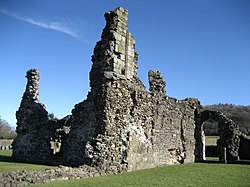Difference between revisions of "Sawley Abbey"
(Created page with "{{Infobox monastery |name=Sawley Abbey |county=Yorkshire |riding=West |village=Sawley |picture=Salley Abbey - geograph.org.uk - 1736378.jpg |picture capt...") |
|||
| Line 3: | Line 3: | ||
|county=Yorkshire | |county=Yorkshire | ||
|riding=West | |riding=West | ||
| − | |village=[[Sawley, | + | |village=[[Sawley, Ribble Valley|Sawley]] |
|picture=Salley Abbey - geograph.org.uk - 1736378.jpg | |picture=Salley Abbey - geograph.org.uk - 1736378.jpg | ||
|picture caption=Sawley Abbey | |picture caption=Sawley Abbey | ||
| Line 14: | Line 14: | ||
|website={{EH link}} | |website={{EH link}} | ||
}} | }} | ||
| − | '''Sawley Abbey''' was an abbey of Cistercian monks in the village of [[Sawley, | + | '''Sawley Abbey''' was an abbey of Cistercian monks in the village of [[Sawley, Ribble Valley|Sawley]], in the [[West Riding of Yorkshire]]. |
Created as a daughter-house of [[Newminster Abbey]], Sawley existed from 1147 until its dissolution in 1536, during the reign of King Henry VIII. A monk here, William de Remmyngton went on to become Chancellor of the [[University of Oxford]] in 1372-3. The last two abbots of Sawley were both put to death. Thomas Bolton was executed as a consequence of his resistance to the dissolution<ref>[http://etd.lsu.edu/docs/available/etd-06012011-203430/unrestricted/altazindiss.pdf.pdf The Northern Clergy and the Pilgrimage of Grace]: Altazin, Keith (PDF)</ref><ref>{{Cite book|title=The Religious Orders in England|url=https://books.google.com/books?id=eEhFlM6Qf7YC|publisher=Cambridge University Press|date=1979-09-27|isbn=9780521295680|language=en|first=David|last=Knowles|first2=Dom David|last2=Knowles}}</ref> and William Trafford, the last Abbot, was executed in Lancaster on the 10th March 1537 alongside John Paslew, the last Abbot of [[Whalley Abbey]], for alleged involvement in the Pilgrimage of Grace. | Created as a daughter-house of [[Newminster Abbey]], Sawley existed from 1147 until its dissolution in 1536, during the reign of King Henry VIII. A monk here, William de Remmyngton went on to become Chancellor of the [[University of Oxford]] in 1372-3. The last two abbots of Sawley were both put to death. Thomas Bolton was executed as a consequence of his resistance to the dissolution<ref>[http://etd.lsu.edu/docs/available/etd-06012011-203430/unrestricted/altazindiss.pdf.pdf The Northern Clergy and the Pilgrimage of Grace]: Altazin, Keith (PDF)</ref><ref>{{Cite book|title=The Religious Orders in England|url=https://books.google.com/books?id=eEhFlM6Qf7YC|publisher=Cambridge University Press|date=1979-09-27|isbn=9780521295680|language=en|first=David|last=Knowles|first2=Dom David|last2=Knowles}}</ref> and William Trafford, the last Abbot, was executed in Lancaster on the 10th March 1537 alongside John Paslew, the last Abbot of [[Whalley Abbey]], for alleged involvement in the Pilgrimage of Grace. | ||
Revision as of 13:35, 21 September 2017
| Sawley Abbey | |
|
Yorkshire | |
|---|---|
 Sawley Abbey | |
| Location | |
| Location: | 53°54’48"N, 2°20’30"W |
| Village: | Sawley |
| Order: | Cistercian |
| History | |
| Founded: | 1147 |
| Disestablished: | 1536 |
| Information | |
| Owned by: | English Heritage |
| Website: | Sawley Abbey |
Sawley Abbey was an abbey of Cistercian monks in the village of Sawley, in the West Riding of Yorkshire.
Created as a daughter-house of Newminster Abbey, Sawley existed from 1147 until its dissolution in 1536, during the reign of King Henry VIII. A monk here, William de Remmyngton went on to become Chancellor of the University of Oxford in 1372-3. The last two abbots of Sawley were both put to death. Thomas Bolton was executed as a consequence of his resistance to the dissolution[1][2] and William Trafford, the last Abbot, was executed in Lancaster on the 10th March 1537 alongside John Paslew, the last Abbot of Whalley Abbey, for alleged involvement in the Pilgrimage of Grace.
The ruins of Sawley Abbey, which are now controlled by English Heritage, are open to the public. Although not an extensive ruin, there are boards on the site that give information regarding the history of the abbey and its former inhabitants. Today, parts of the church and refectory can still be seen.
The abbey is a Grade I listed building and Scheduled Ancient Monument.[3]
In March 2009, Sawley Abbey was featured in the first episode of series 3 of the TV series The Tudors.
Pictures
Outside links
| ("Wikimedia Commons" has material about Sawley Abbey) |
References
- ↑ The Northern Clergy and the Pilgrimage of Grace: Altazin, Keith (PDF)
- ↑ Knowles, David; Knowles, Dom David (1979-09-27) (in en). The Religious Orders in England. Cambridge University Press. ISBN 9780521295680. https://books.google.com/books?id=eEhFlM6Qf7YC.
- ↑ Images of England — details from listed building database (183470) Sawley Abbey

